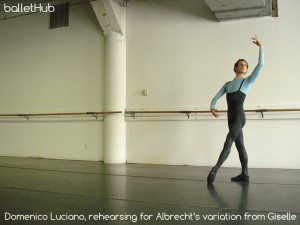How Going for It Can Better Your Dancing
Leave a CommentRecently, I had the opportunity to watch a master at work: I took photos at a Master Class taught by the one and only Edward Ellison, which meant I got to be a fly on the wall and soak up his words of wisdom. Among my favorites? “I want to see your fire.”
It was interesting, because obviously, every dancer in that studio was passionate about ballet. They had risen on a Sunday morning to take an optional class, they listened intently and worked to apply correction, and tried to move with steely accuracy. There were perfect fifth positions, gorgeous lines, and precise landings, but “fire”–or the ability to go for it–was the difference maker. It made me think about my favorite dancers, the ones I grew up idolizing, and what made them so special: They shared an intangible x-factor that made their arabesques seem higher, their turns whip around faster, and their entire movement more alive. You could practically see them throwing themselves into every step, holding nothing back, and moving with this sense of fearless abandon. It is this feeling that makes ballet so captivating.
While technique is the tool, skill, and foundation that’s fundamental to ballet, courage, passion, and artistry are what make a dancer.
As a student, it is tricky to balance that feeling, because you want to do every step perfectly, which means you’re worried about technique, being exact, and doing everything right. These are admirable motivations–after all, what is ballet without technique? Technique is the foundation. But going for it is often what gets you there. So, how does one strike a balance between taking the chances that make you a better dancer and still trying to do your best?
Perhaps a major fear surrounding taking chances, pushing yourself beyond your comfort zone, and going for it is being scared to fail. Countless dancers are perfectionists by nature, which is what makes them so driven and devoted to their craft. However, from a psychology standpoint, fear of failure can actually deter success. We become too afraid to try because we want to get it right. We don’t want to step out of our comfort zone because we don’t want to be wrong. Despite this, “going for it,” is how you learn the boundaries of your current abilities, test temporary limits, and eventually allow yourself to grow as an artist physically and mentally.
While technique is the tool, skill, and foundation that’s fundamental to ballet, courage, passion, and artistry are what make a dancer. If you stay within the limits of what you know, you don’t give yourself the opportunity to reach new heights. Going for it doesn’t have to be flashy, or demanding attention, but it does entail turning inward and finding your fire, so to speak. What’s that little extra push that allows you to go a bit further? Is it confidence? Is it passion? Really, it is a combination of the two that enables you hit that fifth position, hear the music, and give it everything you have.
When you play it safe and dance small, you take away opportunities to see what you are capable of, and where you want to go.
Sometimes, we don’t know what we can do until we do it. I was thinking back on my own training, when I was eleven or twelve and was in one of my first pointe classes. We were working on going down the barre with one hand, stepping into a coupé pique. I’m sure we all looked very much like we were waiting to fall: Nervously gripping the barre, timidly scooting onto pointe in terror. My teacher, after fifteen minutes of urging us to “step out” and “go forward,” finally uttered: “You’re being so careful that you’re going to hurt yourself.” The idea was that caution isn’t always your friend, nor does it give you the desired outcome. Of course, there were times that I fell—not just in that step, but in countless others as well. Just as you don’t know how to balance until you let go of the barre, sometimes, you have to risk the slip in order to get the step, so to speak.
Ballet is built on routine: It is created of the same steps, repeated, typically, in the same order that is barre and center work. This routine is what allows performances to unfold so masterfully, and affords dancers the opportunity to be creative within their interpretation of choreography and character. However, that routine is what you make of it. When you play it safe and dance small, you take away opportunities to see what you are capable of, and where you want to go. Give yourself permission to get a step wrong, to miss so you can move forward, to find the fire that makes good dancers into great ones. Come out of your shell. Let your body move without your brain second-guessing it. Sometimes, trying to be perfect can get in the way of what is really good. No good ever came from fear of failure, but in terms of going for it, bettering your technique, and establishing the next stage of your dancing, it is your fire that lights the way. Let it burn.



